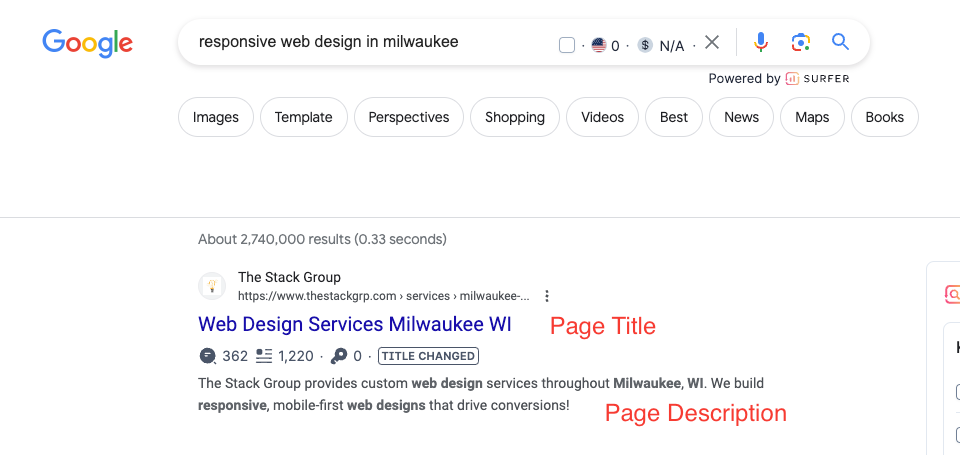Basic SEO for Your Website: Your Essential Starter Kit for Online Success
Share article
How can basic SEO skills boost visibility in search results? This guide cuts straight to the chase, providing you with actionable (beginner - don't worry - we'll keep it as simple as possible but still detailed) steps to optimize your website effectively. Discover the core principles of Basic SEO for your website without the jargon, ready to apply today for immediate results. For those who are advanced, ya might learn a thing or two as well.
Key Takeaways
- Understanding SEO basics, including improving rankings and optimizing content with keywords, is crucial for increasing website visibility and drawing more traffic.
- Search engines use algorithms to rank sites based on factors like relevance and user experience, and SEO tools such as Google Keyword Planner and Ahrefs aid in the discovery and analysis of effective keywords.
- Creating quality content that aligns with SEO goals, optimizing for a good user experience (especially on mobile), and building a solid site structure are key to enhancing rankings and engaging users.
Understanding SEO and Its Impact on Your Website

SEO, or search engine optimization, holds a powerful position in the digital world. Search engine optimization (SEO), is the art and science of making your website more visible on search engines like Google and Bing. But why does this matter? Well, imagine a bustling street market with hundreds of businesses. How do you make sure customers find your business amidst the crowd? SEO is the bright, colorful sign that draws customers to your company in the vast digital market. By understanding SEO basics, including technical SEO, you can effectively optimize your website and increase its visibility.
The effectiveness of SEO is demonstrated through the organic traffic it attracts, the brand awareness it spreads, and the solid online foundation it establishes for your site. It’s like having a 24/7 marketing agent tirelessly promoting your website, ensuring that your brand stays in the spotlight. With the right SEO strategy, your website can generate leads cost-effectively, increase brand awareness, and even offer an impressive long term return on investment.
So, how does SEO make your website more visible? Through enhancing its rankings on search engines. The higher your website appears in organic search results, the more likely people are to click on it when they search for related content. This not only brings in more visitors but also helps to spread the word about your brand. And voila! You’re on your way to achieving online success with SEO.
Decoding Search Engines: How They Rank Your Site

Having grasped the power of SEO, one may question how search engines, the elusive digital gatekeepers, order websites. They use complex algorithms to analyze and rank websites based on factors like relevance, authority, and user experience. Think of these algorithms as the secret recipe that search engines use to serve up the most relevant search results.
Search engines such as Google, Bing, and other search engines scan, index, and order websites to provide users with the most accurate and pertinent results on search engine results pages when they search for something.
They scrutinize various elements like:
- Quality backlinks
- Mobile compatibility
- Page speed
- The uniqueness of the content
- Keywords
- User experience and helpful content
For more info, check out Google's feedback on this topic >
Kickstarting Keyword Research: The Foundation of SEO

As for keywords, these constitute the bedrock of SEO. Keyword research is all about finding and analyzing the words and phrases that people use when they’re searching online. It’s like learning the language of your audience and communicating in a way they understand.
Identifying and targeting relevant keywords helps search engines understand your content and match it with what people are looking for. This leads to better visibility and ultimately, more traffic for your website. This truly is first base in terms of strategy as it's the gateway to creating content that targets specific search queries. But how do we discover these magical keywords?
This is where SEO tools come into play, helping you find the golden keywords that can drive more traffic to your website. With the right tools, you can uncover a treasure trove of keywords that perfectly align with your website’s goals. Some popular SEO tools include:
- Google Keyword Planner
- SEMrush
- Moz Keyword Explorer
- Ahrefs
- Ubersuggest
Using these tools can greatly improve your website’s visibility and attract more organic traffic.
Unveiling Search Intent
To excel in keyword research, it’s crucial to explore further into the domain of search intent. Search intent, or ‘user intent’, is the main goal a user has when typing a query into a search engine. It’s understanding not just what your audience is searching for, but why they’re searching for it.
There are four main types of search intent: navigational, informational, transactional, and commercial investigation. By understanding the intent behind user searches, we can create content that meets their needs, leading to higher rankings and conversions.
Unveiling the search intent of a keyword can be achieved with SEO tools that automatically determine what people are looking for. Additionally, examining the type of content Google displays for those keywords provides valuable insights into search intent.
Tools for Keyword Discovery
Having revealed the concept of search intent, let’s navigate through the wealth of keyword discovery tools. SEO tools like Google Keyword Planner, Ubersuggest, and Ahrefs are invaluable for finding and analyzing potential keywords for your website.
Each of these tools brings a unique set of capabilities to the table:
- Google Keyword Planner: offers insights directly from Google’s vast database. You have to access this through google ads.
- Ubersuggest: brings in Google’s autocomplete results, offering a plethora of valuable keyword ideas
- Semrush: renowned for its advanced keyword exploration features, helping you find high-traffic keywords you can rank for.
By leveraging these tools, you can uncover the keywords your audience is using, helping you craft content that resonates with their needs. With your keywords in hand, you’re now ready to embark on the next stage of your SEO journey: crafting quality content.
Crafting Quality Content: Aligning with SEO Goals

Crafting high-quality, SEO-friendly content can be compared to preparing a delicious meal. You’ve got your ingredients (keywords), and now it’s time to whip up a feast that your audience (and search engines) will love. But how do you ensure that your content is not only enticing but also aligns with your SEO goals?
Consider your content as the connecting link between the needs of your audience and what your business has to offer. The key to building this bridge effectively lies in understanding your audience and crafting content that provides value while seamlessly incorporating your target keywords. It’s not just about stuffing keywords into your content but weaving them into a compelling narrative that engages your audience and satisfies their search intent.
By aligning your content creation with SEO goals, you not only cater to your audience’s needs but also signal to search engines that your content is relevant and valuable. This twofold approach can significantly enhance your website’s visibility and drive more organic traffic your way.
In simple terms according to Google, create content that is helpful to the users query. At the end of the day - does your content help more for that particular targeted search than the results that currently show up in the search results? That's what it's all about. Take away all the fluff and details on SEO - in simple terms, if you want to show up on page one - your content, in relation to the search terms you want to rank for, should be better than what currently ranks.
**Quick mention on AI - yes AI is okay in the eyes of Google - but AI alone tends to not bring a level of reliability and helpfulness alone as human generated content. Additionally and on the flip side, human alone content tends to fall short as well as it tends to leave out various terms, topics, and content ideas that AI could find to improve your content in relation to the search results currently showing. Our recommendation, type the cyborg approach. Leverage AI for data, analytics and content layout and merge that with the human element.
The Art of On-Page Optimization
While it’s vital to create engaging content, it’s just as important to optimize this content for search engines. This process is known as on-page optimization. Think of it as the seasoning that enhances the taste of your meal. It includes various elements such as:
- Headings
- Images
- Meta tags
- Keywords
Proper keyword usage is crucial for on-page optimization. By strategically placing your keywords in:
- your content
- title tags
- meta descriptions
- headers
You can significantly improve your website’s visibility in search engine results.
However, your optimization efforts shouldn’t stop at keywords. The formatting of your content also plays a crucial role in on-page optimization. By breaking up your content with subheadings, bullet points, and images, you can improve its readability, making it more appealing to both your audience and search engines.
Balancing Keywords and Readability
When optimizing your content, it’s crucial to find a balance between incorporating keywords and maintaining readability. While keywords are crucial for search engines to understand your content, stuffing too many keywords can make your content difficult to read and may even lead to penalties from search engines.
So, how do you ensure your content is both keyword-rich and easy to read?
- Aim for a keyword density of 1-2%.
- Focus on making your content easy to read and relevant.
- Remember, your primary audience is human readers, not search engine bots.
Here are some tools that can help with different aspects of your content:
- SEO Review Tools: Helps with keyword optimization and SEO analysis
- Grammarly: Helps with grammar and spelling checks
- Hemingway Editor: Helps with improving readability and simplifying your writing
- Scalenut’s Keyword Density checker: Helps with checking the keyword density in your content. Check it out here>
these tools can ensure that your content is both keyword-rich and reader-friendly.
Building a Solid Site Structure for SEO Success

Once you’ve created and optimized your content, the following step in your SEO process is to accommodate it within a logically organized website. A well-organized website with clear navigation and internal linking helps search engines crawl and index your content more effectively.
Just as a well-organized library makes finding books easier, a well-structured website makes it easier for search engines to understand and index your content. This, in turn, enhances your visibility in search engine results and makes it easier for your audience to find what they’re looking for.
So, how can you create a solid site structure? Start with a clear hierarchy with your homepage at the top followed by main sections or categories. Ensure that every page on your site is reachable with a minimal number of clicks from the homepage. This not only improves user experience but also helps search engine bots to crawl your site more efficiently.
Mastering Meta Tags and Descriptions

During the optimization of your website, don’t underestimate the influence of meta tags and descriptions. These are small snippets of text that describe a page’s content and appear in the page’s HTML code. They don’t appear on the page itself but are displayed in search engine results.
Optimizing your title tags and meta descriptions can significantly improve your website’s visibility in search engine results. A compelling meta description acts as a mini-advertisement for your content and can influence whether users decide to click on your page or not.
While there’s no one-size-fits-all approach to creating the perfect meta tags and descriptions, there are a few best practices to follow. Aim to write unique, concise, and engaging descriptions that accurately describe your content and make users want to click to learn more.
PRO TIPS:
- Page Titles should be no more than 65 characters long
- Page Descriptions should be between 70-155 characters long
Optimizing for Mobile Users

While improving your website’s user experience, give particular consideration to your mobile users. With the growing number of people accessing the internet via their smartphones, making your website mobile-friendly is no longer a luxury – it’s a necessity.
Mobile optimization involves:
- Ensuring your website looks and performs well on mobile devices
- Using responsive design to adjust your site’s layout to different screen sizes
- Ensuring your content is consistent across desktop and mobile versions.
Remember, a mobile-optimized website is not just about aesthetics; it’s also about speed. With mobile users often on the go, they expect websites to load quickly. A slow website can lead to high bounce rates and low user engagement, negatively impacting your search rankings.
Streamlining Page Speed
On the topic of speed, let’s delve into the ways you can enhance your website’s page speed. Page speed refers to how quickly a web page loads and is a crucial factor in both user experience and SEO.
Several factors can slow down your page speed, including:
- Unoptimized images
- Too many HTTP requests
- Bulky codes
- A sluggish server
Addressing these issues can significantly improve your page speed, leading to a better user experience and improved search rankings.
We recommend Page Speed Insights by google for testing your sites speed and other insights:
By monitoring and improving your page speed, you can enhance your user experience, improve your search rankings, and ultimately drive more traffic to your site.
Link Building: Establishing Authority and Trust
Within the intricate maze of SEO, the practice of link building holds a pivotal position. It involves earning backlinks from other reputable websites, which helps establish authority and trust for your website. Backlinks are like votes of confidence from other websites, signaling to search engines that your content is valuable and trustworthy. Some key benefits of link building include:
- Increased organic search rankings
- Improved website visibility and traffic
- Enhanced credibility and authority in your industry
- More opportunities for collaboration and partnerships
Implementing a strategic link building strategy can greatly impact the success of your website and improve your overall SEO efforts.
But how do you earn these valuable backlinks? There are several strategies you can use, including guest blogging and leveraging social media for link opportunities. By focusing on creating high-quality content and building relationships with other reputable websites, you can earn high-quality backlinks that boost your website’s authority and search rankings.
Remember, effective link building isn’t about quantity; it’s about quality. A few high-quality backlinks from reputable websites are far more valuable than a large number of low-quality links from dubious sources. So focus on earning valuable backlinks that align with your brand and contribute to your overall SEO strategy.
Leveraging Social Media for Link Opportunities
Another potent platform for link building is social media. By sharing your content on social media platforms, you can attract more backlinks, improve your website’s search engine ranking, and reach a larger audience.
Each social media platform offers unique opportunities for link building. Here are some examples:
- YouTube allows you to include backlinks in video descriptions
- Twitter allows you to share links in tweets
- LinkedIn allows you to include links in your profile and posts
By understanding the unique features of each platform, you can leverage social media to boost your link building efforts.
Remember, successful social media link building requires engaging with your audience and providing valuable content. By focusing on creating valuable, engaging content that resonates with your social media audience, you can attract more backlinks, boost your website’s authority, and ultimately improve your SEO performance.
Utilizing Google Search Console for SEO Insights
Equipped with optimized content, a logically organized website, and a strong link-building strategy, you’re making significant strides towards SEO success. But how do you measure this success? Enter Google Search Console, your backstage pass to your website’s performance data.
Google Search Console offers a wealth of insights into your website’s performance. From search traffic data to indexing issues, this free tool provides valuable insights that can help you refine your SEO strategy. By monitoring your performance data regularly, you can identify areas where your website is performing well and areas where improvements are needed.
In addition to monitoring performance, Google Search Console is also a valuable tool for keyword analysis. By highlighting the keywords that are driving traffic to your website, Google Search Console can help you refine your keyword strategy and focus on the keywords that are most effective at driving traffic and conversions.
Local SEO: Capturing Nearby Customers
While global SEO aims at reaching audiences across the globe, local SEO zeroes in on attracting customers within your local vicinity. By optimizing your website for local searches, you can attract more nearby customers and increase your online presence in your target area.
Local SEO involves optimizing your website for location-based keywords, claiming and optimizing your Google My Business listing, and managing online reviews. By focusing on these local SEO strategies, you can ensure that your business appears in local search results, driving more local customers to your business.
Remember, successful local SEO requires a comprehensive, tailored approach. By understanding your local market and optimizing your website accordingly, you can capture more local customers and boost your online presence in your local area.
Measuring and Analyzing SEO Performance
Once your SEO strategies have been put into action, it becomes necessary to assess their efficacy. By measuring and analyzing key SEO metrics, you can assess the success of your SEO efforts and make data-driven improvements.
Key SEO metrics to monitor include organic traffic, keyword rankings, and conversions. By tracking these metrics, you can gain valuable insights into your website’s performance and identify areas for improvement.
There are numerous tools available to help you measure and analyze your SEO performance, including:
- Google Analytics
- SEMrush
- Ahrefs
- Moz
These tools provide valuable insights into your website’s organic traffic, keyword rankings, and other key SEO metrics, allowing you to refine your SEO strategy based on data-driven insights.
Summary
Well you might think, well that seemed very detailed - I assure you, this was a basic overview of successful SEO techniques and strategies without going into the advanced details behind each main topic covered. Remember, at the end of the day, SEO gurus aside, there is no perfect practice and no "this is the google algorithm for exactly how to rank." Google continues to suggest, create the best user experience and the most helpful content around the search terms you are targeting. Taking that mindset and coupling that with some of the more technical aspects of SEO we mentioned above, you should create the best foundation for your business's online presence.
Final Thoughts
First off, congrats if you made it to the end. This was a very compressed detailed guide for SEO practices. I understand that, for business owners, you're already wearing multiple hats and are stretched thin. For those that have the capacity, you can apply these techniques to achieve SEO success. For those who want to hire out, you can leverage
affordable SEO services by top SEO agencies to achieve success in organic search. Remember, the key is to be consistent in implementing these techniques and strategies over time. With patience and persistence, you can see significant improvements in your website's search engine ranking and overall online presence.
Questions? Have a project you're ready to launch?
Simply text our team at
(857) 256-1295 or send us a message!
Latest Articles




